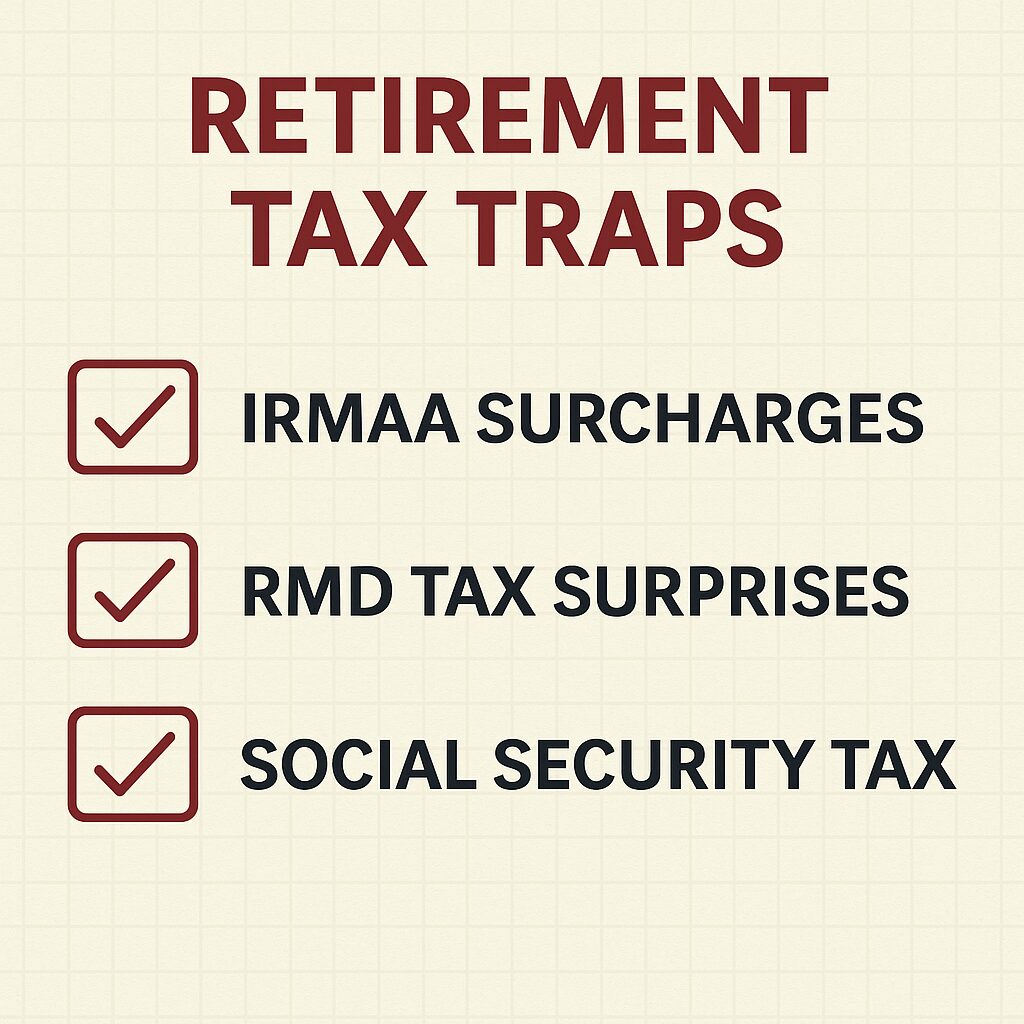
Avoid costly surprises that can shrink your Social Security, inflate your Medicare premiums, and derail your retirement plan.
Most retirees think their tax worries end when the paychecks stop.
Wrong.
In reality, retirement comes with a new set of hidden tax traps—and if you’re not careful, they can quietly eat away at your Social Security, Medicare benefits, and retirement income.
This post exposes three of the most common (but least discussed) retirement tax pitfalls—and shows you how to sidestep them with a little planning.
✅ 1. IRMAA: The Stealth Medicare Penalty
You may have never heard of IRMAA, but it could cost you hundreds (or even thousands) of dollars a year in higher Medicare premiums.
IRMAA stands for Income-Related Monthly Adjustment Amount. If your income is above certain thresholds, you’ll pay extra for both Medicare Part B and Part D—even if you’re already enrolled.
For 2024, IRMAA surcharges kick in if your Modified Adjusted Gross Income (MAGI) exceeds:
- $103,000 for single filers
- $206,000 for married couples filing jointly
These thresholds are based on your tax return from two years ago, so a Roth conversion or capital gain today could raise your Medicare premiums two years from now.
✅ Tip: Use Roth IRAs, qualified charitable distributions (QCDs), and smart withdrawal sequencing to stay under IRMAA cliffs.
✅ 2. The RMD Tax Shock
Required Minimum Distributions (RMDs) are mandatory withdrawals from traditional IRAs and 401(k)s starting at age 73 (for most retirees). And they’re fully taxable.
Here’s the trap: Even if you don’t need the money, you must take the RMD—and the extra income can:
- Push you into a higher tax bracket
- Trigger IRMAA
- Make more of your Social Security taxable
Worse, the longer you wait to take money from your IRA, the larger your RMDs can become—because account balances grow, and withdrawal percentages increase with age.
✅ Tip: Consider Roth conversions before age 73 to reduce future RMDs and shift taxable income to earlier (lower-income) retirement years.
✅ 3. Taxing Your Social Security
Up to 85% of your Social Security benefits can be taxed, depending on your “combined income” (AGI + tax-free interest + ½ of Social Security benefits).
Here’s how it works:
- If combined income is $25,000+ (single) or $32,000+ (married), part of your benefits will be taxed.
- Above $34,000 (single) or $44,000 (married), up to 85% of your benefits may be taxable.
These thresholds have never been adjusted for inflation—which means more retirees are hit with the tax each year.
✅ Tip: Use tax-efficient withdrawal strategies (like tapping Roth IRAs or selling long-term investments) to lower your AGI and keep Social Security tax-free.
🧓 Real-Life Example: Bob & Linda’s RMD Wake-Up Call
Bob and Linda, both 72, delayed IRA withdrawals and lived off other savings. But at 73, Bob’s RMD totaled over $38,000. That pushed them into a higher tax bracket, increased their Medicare premiums, and made 85% of their Social Security taxable—all in one year.
If they had done small Roth conversions in their 60s, they could have flattened their tax bracket, avoided IRMAA, and enjoyed tax-free Social Security for longer.
✅ The Bottom Line
Retirement isn’t just about collecting checks—it’s about managing income and taxes wisely.
To avoid costly surprises:
- Know where the IRMAA cliffs are—and stay under them
- Prepare for RMDs long before age 73
- Strategically control your taxable income to protect Social Security
With smart planning, you can slash your tax bill and keep more of your hard-earned money working for you.
📘 This post is adapted from my book:
Tax Loopholes Just for Seniors: 33 Ways to Slash Your Taxes Right Now,
Available now on Amazon.com in eBook and paperback formats.
Inside, you’ll find dozens of simple strategies to reduce your retirement tax burden—legally, effectively, and without guesswork.
⚠️ Disclaimer
This content is for educational and informational purposes only. It is not tax, legal, or financial advice. Consult a qualified tax advisor or financial professional to discuss your individual situation. The author is not a licensed CPA or attorney and does not provide personalized tax advice.